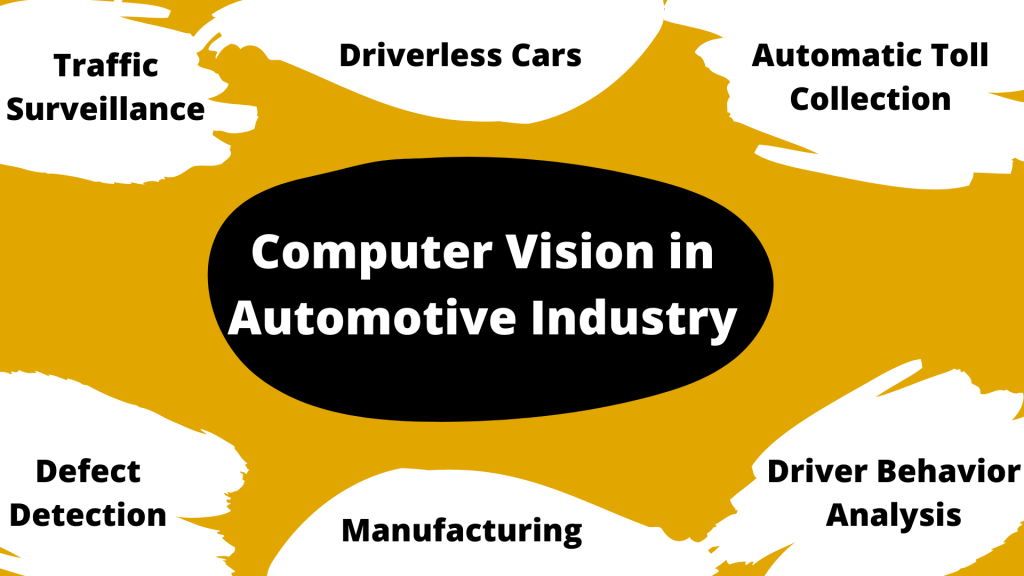Computer vision may not be as complicated as you might think. You could’ve used computer vision in scanning any barcode with your smartphone?
Or if you have googled an image with Google Lens?
As a matter of fact, applications of computer vision are now way more common than they used to be just a few years back.
Most industries are using computer vision along with artificial intelligence to improve their end-products.
In conjunction with AI, computer vision provides next-generation solutions to the perennial industry problems.

What is Computer Vision?
Analogous to human vision, computer vision helps machines to see, observe, and understand. Afterward, artificial intelligence takes over the data for further processing.
Humans have generations of experience genetically coded within them. Consequently, even kids are better at vision perception in comparison to present-day sophisticated machines.
To stand a chance at visual analysis, computers need lots of data and training. But even that might prove insufficient, time-consuming, and costly to produce anything valuable out of it.
Or doing it the smart way, machines can take cues from the human brain.
A human brain learns from experience. A convolutional neural network (CNN) helps machines to process images–much like their lively counterparts.
How does Computer Vision work?
Two things–deep learning and CNNs–help machines to imitate the understanding of a human brain in reference to vision.
CNNs are multilayered neural networks that process and reprocess visual data until any fruitful output.
Along with deep learning, it gets wiser with the experience without needing any additional programming.
First, it breaks down images into smaller segments to identify simple shapes. Then it proceeds to extract more complex information such as irregular shapes, colors, textures.
This process repeats until it arrives at a result–finally recognizing the image and its elements.
Why Computer Vision?
Have you been tricked into purchasing an imperfectly packaged food packet? I have.
Millions of such consumer materials pass through packaging belts every hour in industries. And it’s not economic and efficient to have a set of human eyes to handle that.
Humans get tired easily. Machines, on the contrary, can be trusted with such operations with much peace of mind.
A scanner with CNN algorithms trained in identifying defects could have avoided that food packet situation.
In the automotive industry, even small defects can offset the desired results. And it can risk the safety of the end consumer as well. Computer vision plays a decisive role in avoiding all of that.
Applications of Computer Vision
There are numerous applications of computer vision in the automotive industry. We’ll briefly look upon them.

Self-Driving Cars
Driverless cars without computer vision are a pizza without a base– impossible.
Computer vision allows automated cars to function as safe moving entities on the roads. If not for computer vision, a self-driving car can be a nightmare to fellow commuters and the passengers themselves.
Computer vision enables autonomous cars to analyze traffic conditions in real-time. That provisions for sensible braking and acceleration while in motion.
A properly trained CNN along with a fully developed Artificial Intelligence is the imperative prerequisite for a level 5 fully autonomous car. Interestingly, level 5 won’t need any human supervision while driving. That’s the milestone the autonomous industry is aiming for.
Driver Analysis and Accident Prevention
It can be used in both, self and normal driving situations.
For such conditions, CNNs are trained to identify the activities (or conditions) resembling a distracted (or fatigued) driver such as calling, texting, tilting to grab something, yawning, or a low blinking rate.
Basically–if perfectly trained–this should be able to detect anything suspicious or unnecessary.
Upon detection, it can trigger an alarm to alert the driver. Under any prolonged distraction, it can stop the car immediately at a safe location.
Maintenance and Defect Detection
Computer Vision can discern the surface imperfections like a bend, a hole, improper roughness, etc.
This lends a hand in the maintenance of various parts of an automobile. The defective parts are checked for repair or replacement based on the extent of the damage.
This feature can be used for all consumer products. But this has special significance in the automotive industry.
Since a minor physical defect can negatively affect the overall performance and the user experience.
However, the applications of computer vision fall short in cases where the anomaly isn’t visible on the surface.
Since CNNs are trained for visual image analysis, they can be spoofed in identifying any subsurface problem.
Manufacturing
Handmade cars are nothing short of a fortune at present. Only some of the premium brands are still making man-made cars for the ultra-rich.
For the masses, it has gone robotic in most of the production units long back.
So, manufacturing is enjoying one of the greatest applications of computer vision. And, it’s only going to get bigger by the day.
All the major processes in a production unit like cutting, welding, fitting, painting, etc, are being handled by robotic arms.
And all of it could be a huge waste of time and resources if not for the intelligent CNNs.
Computer vision–being the eye and the brains of the production–is pivotal in giving outputs with millimeter precision in short time spans.
Traffic Engineering
Though not directly related to the automobile industry, traffic engineering is associated with highways that indirectly affect this industry to a great extent.
As a result, effective highway infrastructure is paramount for a satisfactory commuting experience.
Traffic surveys are an integral part of the highway design process. And the most tedious part of doing a traffic survey is traffic count.
Before the automation hit us, survey teams used to sit along roadsides to count the vehicles in various categories–2 wheelers, cars, buses, trucks, mini trucks, etc.
These counts were important for new highway designs and the expansion of old ones.
They were usually taken for a few days to weeks. This acted as an input for the calculation of annual average daily traffic with the help of mathematical modeling.
Given the repetitive nature of work, these counts were often inaccurate because of human negligence in the counting process.
Computer Vision has greatly solved this crisis with the advent of automatic traffic counters. These counters calculate the total no. of vehicles in each category for a set amount of time.
Limitations of Computer Vision
Privacy
To evolve into something exceptional, computer vision needs substantial amounts of data. And unfortunately, we are the only available source.
So you can apply computer vision for the greater good or like infringing upon the personal lives of the commoners.
For instance, driver behavior analysis means that you’re not alone in your car. Someone’s watching.
Consequently, one threatening application of computer vision can be mass surveillance. While few may be indifferent about it, others have their rightful concerns.
Efficiency
In the end, you are handing over important things to a camera with some algorithms.
The absence of a conscience impairs the ability of computer vision to give completely accurate results. And it’s something you can’t do anything about.
It’s evolving, yes. But will it be–ever–able to match human intelligence?
I have my doubts stacked against all such technologies on this one!
